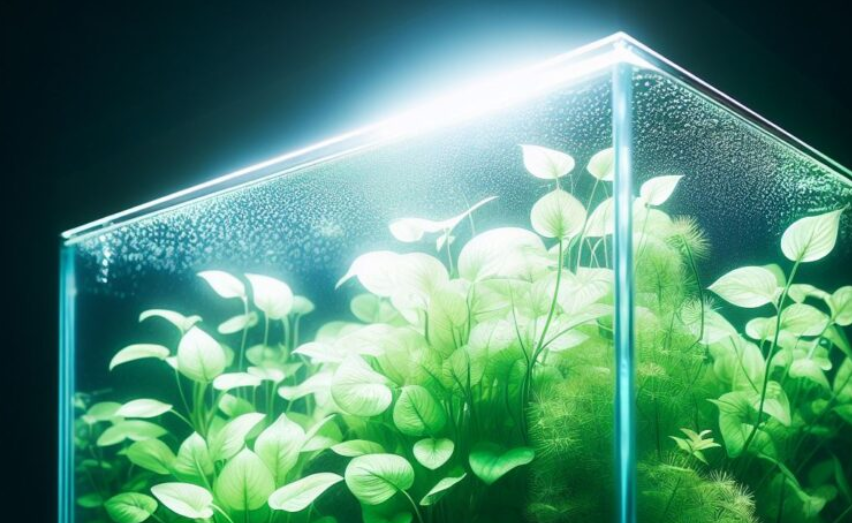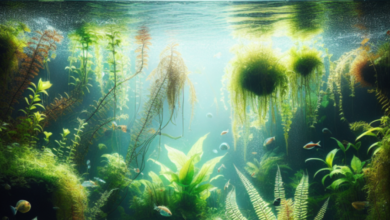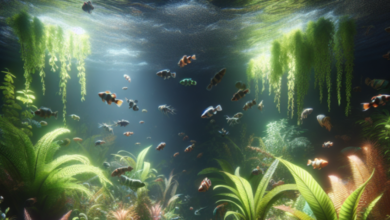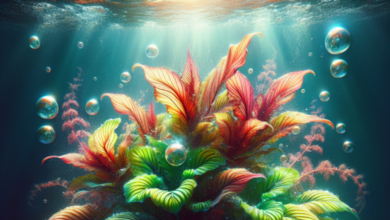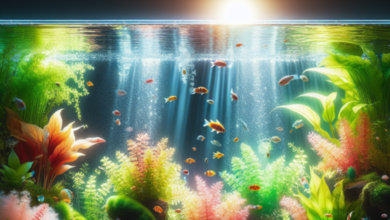Are you a beginner looking to add some greenery to your aquarium but don’t know where to start? Look no further! In this article, we will delve into the best low light aquarium plants that are perfect for beginners and require minimal lighting.
Low light aquarium plants not only thrive in suboptimal lighting conditions but also offer easy care and add beauty to your aquarium setup. Read on to discover some popular low light plant options and how they can contribute to the overall health of your aquatic ecosystem.
Key Takeaways
- Low light aquarium plants are an excellent option for beginners.
- Low light plants require minimal maintenance and are less prone to algae growth.
- Anubias, Java Fern, Cryptocoryne, and Vallisneria are some of the most popular low light plant varieties.
- Proper lighting, substrate selection, and fertilization are essential for low light plant maintenance.
- With the right selection and care, you can create a thriving and beautiful aquatic ecosystem in your aquarium.
Understanding Low Light Conditions
Before we can dive into the best low light aquarium plants, it’s essential to understand what low light conditions mean. Low light conditions in an aquarium refer to setups that have limited access to natural or artificial light. These setups may be due to factors such as room placement, lack of windows, or a desire to limit the use of artificial lighting.
Low light aquariums are a great choice for beginners as they offer a less demanding environment for both aquatic plants and animals. However, it’s important to note that not all plants can thrive in low light conditions, and it’s essential to choose the right ones for your aquarium’s success.
Benefits of Low Light Aquarium Plants
Low light aquarium plants are a great choice for beginners who want to add plants to their aquarium. These plants offer several benefits that make them an ideal choice.
- Hardiness: Low light plants are generally hardier and more tolerant to suboptimal lighting conditions, making them an excellent choice for hobbyists who are new to aquarium plant care.
- Low maintenance: Low light plants require less maintenance than other aquarium plants. This is because they grow more slowly and are less prone to algae growth. As a result, you can spend less time caring for your plants and more time enjoying your aquarium.
- Contribute to aquarium ecosystem: Low light plants help to create a healthy aquarium ecosystem by absorbing carbon dioxide and producing oxygen. They also provide shelter and hiding places for fish and other aquatic species.
If you’re looking for a beautiful and low maintenance addition to your aquarium, low light plants are an excellent choice.
Choosing the Right Low Light Aquarium Plants
When it comes to selecting low light aquarium plants, it’s important to consider a few key factors to ensure the best possible setup for your aquatic ecosystem. Here are some of the most crucial considerations to keep in mind:
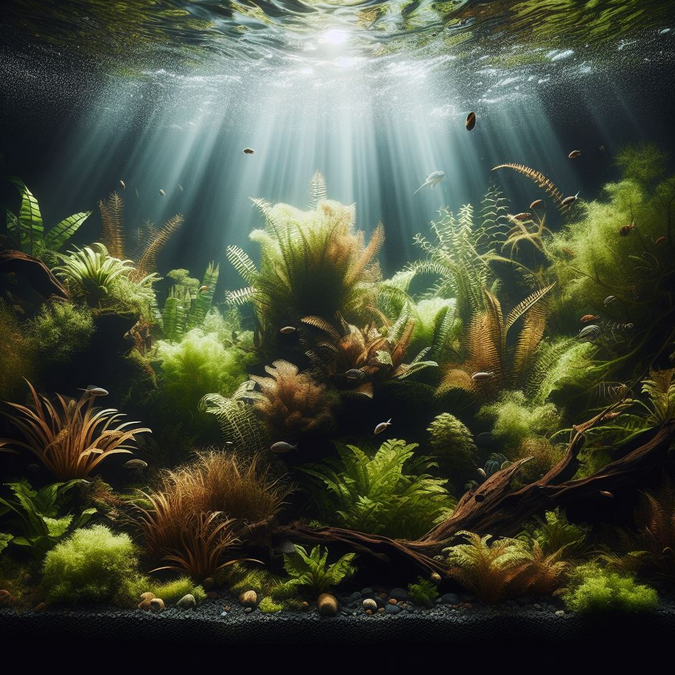
- Plant Size: It’s important to select plants that won’t outgrow your tank or overcrowd the space. Choose plants with a smaller size or moderate growth rate to ensure a healthy and sustainable environment.
- Growth Rate: Some low light plants grow more quickly than others, and it’s important to select plants that fit your desired speed of growth. Consider the expected growth rate of each plant and choose accordingly.
- Compatibility: It’s crucial to select plants that are compatible with the other aquatic species in your tank. Certain plants may offer more cover or hiding spots for some species, while others may disrupt the ecosystem. Take into account the needs of your aquatic pets and ensure a proper balance.
An Overview of Popular Low Light Aquarium Plants
Here are some popular low light aquarium plants that are well-suited to beginner setups:
| Plant Name | Size | Growth Rate | Compatibility |
|---|---|---|---|
| Anubias | Small to Medium | Slow to Moderate | Compatible with most species |
| Java Fern | Small to Large | Slow to Moderate | Compatible with most species |
| Cryptocoryne | Small to Large | Slow to Moderate | Compatible with most species |
| Vallisneria | Small to Large | Slow to Moderate | Compatible with most species |
Consider these popular low light aquarium plants when selecting the perfect addition for your aquarium setup. Keep in mind the crucial factors mentioned above to ensure the best possible outcome for your aquatic friends.
Anubias: Versatile Low Light Plants
If you’re looking for aquatic plants that are versatile and can tolerate low light conditions, Anubias is an excellent choice. This plant is native to Africa and comes in various shapes and sizes, making it a popular choice among aquarium enthusiasts. Here are some of the types of Anubias that you might find in your local fish store:
| Anubias Species | Size | Features |
|---|---|---|
| Anubias Barteri | Small to Medium | – Slow-growing – Dark green leaves – Rhizome system |
| Anubias Nana | Small | – Dwarf variety – Round, small leaves – Suitable for aquascaping |
| Anubias Congensis | Medium to Large | – Long, narrow leaves – Tolerant to high light conditions – Can be planted in gravel |
Anubias is an easy-care plant that requires minimal maintenance. It can grow in a variety of substrates but prefers a nutrient-rich environment. Place the plant’s rhizome above the substrate to avoid rotting. Anubias is also an excellent choice for beginner aquascapers, as it does not require CO2 injection and can tolerate a wide range of water parameters.
Another unique feature of Anubias is its ability to flower underwater, producing small white blooms that can add visual interest to your aquarium. Overall, Anubias is a versatile plant that can thrive in many aquarium setups, making it an excellent choice for any aquarist looking to add greenery to their low light tank.
Java Fern: Resilient and Beautiful
Java Fern is a stunning low light aquarium plant that is known for its durability and remarkably ornamental foliage. It’s versatile, easy to care for, and a great choice for beginners. If you’re looking for a plant that can thrive in low light conditions, then Java Fern could be the perfect addition to your aquarium.
Types of Java Fern
There are different species of Java Fern, each with unique features. The most common types of Java Fern include:
- Java Fern (Microsorum pteropus)
- Windelov Fern (Microsorum pteropus ‘Windelov’)
- Needle Leaf Fern (Microsorum pteropus ‘Narrow Leaf’)
The standard Java Fern (Microsorum pteropus) is the most common and can grow up to 13 inches tall. Windelov Fern (Microsorum pteropus ‘Windelov’) has curly leaves that create a sense of motion in the water; it’s a great choice for foreground plants. Needle Leaf Fern (Microsorum pteropus ‘Narrow Leaf’) has thin, elegant leaves that can grow up to 10 inches long.
Care Requirements
Java Fern is an undemanding plant that can tolerate low light levels, but it prefers moderate lighting. It grows best in slightly acidic water with a pH range of 6.0-7.5, and a temperature range of 68-82°F. Java Fern is slow-growing and doesn’t require much fertilization, but it benefits from additional nutrients like iron, magnesium, and potassium.
Aesthetics
Java Fern’s dark green leaves create a lovely contrast against lighter-colored aquarium substrates, rocks, and driftwood, adding depth and dimension to your aquarium. The plant’s broad, wavy leaves can also provide hiding places for fish and invertebrates.
Propagation
Java Fern propagates through rhizome division, which occurs naturally as new plantlets appear on existing rhizomes. Once these new plantlets form roots, you can cut them and replant them in the substrate or attach them to rocks or driftwood with fishing line or glue. This plant can also grow from spores, although the process is less common.
Overall, Java Fern is a resilient and beautiful low light aquarium plant that can help create a stunning aquatic environment. With its unique foliage, slow growth rate, and easy care, it’s a favorite among many aquarium enthusiasts.
Cryptocoryne: Hardy Low Light Plants
Cryptocoryne plants are an excellent choice for low light aquariums due to their hardiness and compatibility with a variety of aquatic species. These plants are native to Southeast Asia and can survive in various aquatic environments.
Popular Cryptocoryne species for low light aquariums include Cryptocoryne wendtii, Cryptocoryne beckettii and Cryptocoryne lucens. They range in size from small to medium, with long, flexible leaves that add movement and texture to your aquarium.
Care: Cryptocoryne plants thrive in substrate with moderate nutrient content and low to moderate light. They can also tolerate a wide range of water parameters, making them perfect for beginners. However, constant fluctuations in water chemistry can cause Cryptocoryne plants to melt or rot, so it’s essential to maintain consistent water conditions.
| Care Level: | Easy |
|---|---|
| Optimal Lighting: | Low to Moderate |
| Optimal Water Parameters: | pH: 6.0-8.0; Temperature: 72-82°F; Hardness: 3-8 KH |
| Propagation: | Adventitious plants, runners, and rhizome division |
Cryptocoryne plants add a unique and fascinating visual appeal to any aquarium setup. Their hardiness, easy care, and compatibility with a range of aquatic species make them an ideal choice for beginners and experienced aquarists alike.
Vallisneria: Graceful and Easy to Grow
Vallisneria is a popular choice among aquarium enthusiasts for its graceful appearance and ease of care. Also known as Vallis or Val, these low light aquatic plants are native to Asia, Europe, Africa, and North America. With over 60 different species to select from, you’re sure to find one that suits your aquarium’s needs.

Some common types of Vallisneria include:
- Vallisneria Americana
- Vallisneria Spiralis
- Vallisneria Gigantea
- Vallisneria Natans
Vallisneria Spiralis, also known as Corkscrew Vallisneria, is the most popular type of Vallisneria due to its twisted leaves that add an interesting visual element to any aquarium. Vallisneria Gigantea, also referred to as Giant Jungle Val, is another popular choice. It is characterized by its large size, upright growth habit and beautiful green leaves.
Care and Maintenance
Vallisneria is a low light plant that is easy to grow and propagate. The plant can tolerate a wide range of water conditions, including pH levels from 6.5 to 9.0 and temperatures from 68 to 82 °F. They are excellent for absorbing excess nutrients, helping to control algae in your aquarium.
Vallisneria requires a nutrient-rich substrate and prefers moderate to high water flow. This plant propagates through runners, and it’s best to wait for the new plants to establish themselves before trimming the runners.
Vallisneria Care Requirements
| Water pH | 6.5-9.0 |
|---|---|
| Water Temperature | 68-82°F |
| Lighting | Low |
| Propagation | Runners |
Vallisneria is a popular choice for aquarists because of its beauty and ease of care. If you’re looking for a resilient low light plant that can add gracefulness to your aquarium setup, then Vallisneria is worth considering.
Maintenance Tips for Low Light Aquarium Plants
Low light aquarium plants are easy to care for, and with proper maintenance, they can grow and thrive. Here are some valuable maintenance tips to keep your low light plants healthy:
Lighting:
Low light plants still require some light for proper growth. Make sure your aquarium gets 6-8 hours of light daily. You can use a simple light timer to ensure consistent and proper lighting.
Substrate Selection:
When selecting substrate for your low light plants, use a nutrient-rich substrate that will provide essential nutrients such as Iron, Potassium and Manganese, and promote plant growth. A fine-grained substrate like sand is ideal for anchoring roots.
Fertilization:
Low light plants require less fertilization than high light plants. Use a fertilizer that is high in Nitrogen and supports plant growth. Adding Carbon supplements also improves plant growth and development. A little bit goes a long way, be careful not to over fertilize.
Regular Care:
Perform regular water changes to maintain water quality. Remove any dead or decaying plant matter as it can produce ammonia and harm your aquatic species. Keep an eye out for any pest infestations or signs of nutrient deficiencies such as yellowing or decaying leaves.
By following these maintenance tips, you can create a thriving ecosystem for your low light aquarium plants. With a little care, your plants will add natural beauty and enhance the health of your aquatic community.
Conclusion
Low light aquarium plants are an excellent choice for those seeking easy care and visually appealing aquatic setups. The plants mentioned in this article – Anubias, Java Fern, Cryptocoryne, and Vallisneria – offer hardiness, resilience, unique features, and compatibility with various aquatic species, making them an ideal choice for beginners.
Proper maintenance, including lighting, substrate selection, and regular care, is essential for the health and longevity of low light plants. By implementing the tips mentioned in this article, you can create a thriving ecosystem in your aquarium and enjoy the benefits of these captivating low light plants.
Whether you’re a seasoned aquarist or a beginner, these low light aquarium plants are sure to add beauty and life to your aquatic environment. So, go ahead and explore the world of low light aquarium plants and experience the wonders they have to offer.
FAQ
What are low light aquarium plants?
Low light aquarium plants are plants that can thrive in aquarium setups with limited access to natural or artificial light. They are specifically chosen for their ability to grow and flourish in low light conditions.
Why should I choose low light aquarium plants?
Low light aquarium plants offer several benefits. They are generally hardier and more tolerant of suboptimal lighting conditions compared to other plants. They require less maintenance, are less prone to algae growth, and can contribute to the overall health of your aquarium ecosystem.
How do I choose the right low light aquarium plants?
When selecting low light aquarium plants, consider factors such as plant size, growth rate, and compatibility with other aquatic species in your tank. It’s important to choose plants that are well-suited for low light environments and will enhance the aesthetics of your aquarium.
What are some popular low light aquarium plant options?
Some popular low light aquarium plant options include Anubias, Java Fern, Cryptocoryne, and Vallisneria. These plants are known for their ability to thrive in low light conditions and offer unique features that can enhance the visual appeal of your aquarium.
How do I maintain low light aquarium plants?
Proper maintenance is essential for the health and longevity of low light aquarium plants. It’s important to provide appropriate lighting, choose the right substrate, fertilize regularly, and follow a consistent care routine. These steps will help ensure that your low light plants continue to thrive in your aquarium.
